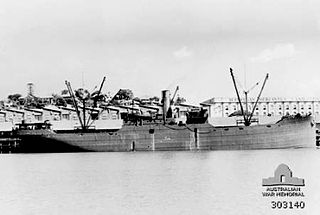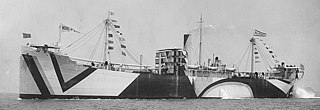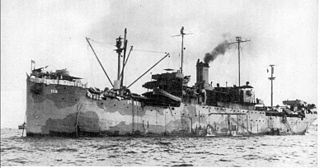Related Research Articles

The United States Shipping Board (USSB) was established as an emergency agency by the 1916 Shipping Act, on September 7, 1916. The United States Shipping Board’s task was to increase the number of US ships supporting the World War I efforts. United States Shipping Board program ended on March 2, 1934.

The Design 1023 ship was a steel-hulled cargo ship design approved for mass production by the United States Shipping Board's (USSB) Emergency Fleet Corporation (EFC) in World War I. Like many of the early designs approved by the EFC, the Design 1023 did not originate with the EFC itself but was based on an existing cargo ship designed by Theodore E. Ferris for the United States Shipping Board (USSB). The ships, to be built by the Submarine Boat Corporation of Newark, New Jersey, were the first to be constructed under a standardized production system worked out by Ferris and approved by the USSB.
The Design 1017 ship was a steel-hulled cargo ship design approved for production by the United States Shipping Board's Emergency Fleet Corporation (EFT) in World War I. They were referred to as the "Downey-type" as they were built by Downey Shipbuilding on Staten Island. 10 ships were completed for the USSB in late 1918 and through 1919. An additional ship was completed in 1920 for a private shipping company.
The Design 1018 ship was a steel-hulled cargo ship design approved for production by the United States Shipping Board's Emergency Fleet Corporation (EFT) in World War I. They were referred to as the "Sun-type" as they were built by Sun Shipbuilding & Drydock Co. in Chester, Pennsylvania. 4 ships were completed for the USSB in late 1919 and through 1920. An additional ship was completed in 1920 for a private shipping company.
The Design 1019 ship was a steel-hulled cargo ship design approved for mass production by the United States Shipping Board's Emergency Fleet Corporation (EFT) in World War I.
The Design 1020 ship was a steel-hulled cargo ship design approved for mass production by the United States Shipping Board's Emergency Fleet Corporation (EFT) in World War I.
The Design 1021 ship was a steel-hulled cargo ship design approved for production by the United States Shipping Board's Emergency Fleet Corporation (EFT) in World War I. They were referred to as the "Long Beach-type" as they were built by Long Beach Shipbuilding Company in Long Beach, California. Three ships were completed for the USSB in 1918 and 1919.
The Design 1012 ship was a steel-hulled cargo ship design approved for production by the United States Shipping Board's Emergency Fleet Corporation (EFT) in World War I. They were referred to as the "Munrio"-type which was the name of the SS Munrio, a similar pre-EFT ship built at the Bethlehem Sparrows Point Shipyard. They were all built by Merrill-Stevens Drydock & Repair Company at their Jacksonville, Florida shipyard. 4 ships were completed for the USSB in 1918 and 1919. An additional order of 17 ships was cancelled.
The Design 1014 ship was a steel-hulled cargo ship design approved for production by the United States Shipping Board's Emergency Fleet Corporation (EFT) in World War I. They were referred to as the "Cascade"-type. They were all built by Todd Shipyards, then part of Todd Drydock and Construction Company, at their Tacoma, Washington shipyard. 20 ships were completed for the USSB in 1919 and 1920; and additional 2 were completed in 1920 for private companies. 12 ships was cancelled.

The Design 1015 ship was a steel-hulled cargo ship design approved for production by the United States Shipping Board's Emergency Fleet Corporation (EFT) during World War I. They were referred to as the "Moore & Scott"-type.

The Design 1016 ship was a steel-hulled cargo ship design approved for production by the United States Shipping Board's Emergency Fleet Corporation (EFT) during World War I. They were referred to as the "Baltimore Drydock"-type.

The Design 1025 ship was a steel-hulled cargo ship design approved for production by the United States Shipping Board's Emergency Fleet Corporation (EFT) in World War I. They were referred to as the "Harriman-type" as the majority of ships were built in the Harriman section of Bristol, Pennsylvania. A total of 62 ships were ordered and built at three shipyards: 40 ships at Merchant Shipbuilding Corporation, Bristol, Pennsylvania; 12 ships at Newburgh Shipyards in Newburgh, New York; and 10 ships at Pensacola Shipbuilding Company in Pensacola, Florida.

The Design 1027 ship was a steel-hulled cargo ship design approved for production by the United States Shipping Board's Emergency Fleet Corporation (EFT) in World War I. They were referred to as the Oscar Daniels-type as all the ships were built at the Oscar Daniels Shipbuilding Company, Tampa, Florida. A total of 10 ships were ordered and built from 1919–1921.
SSCambridge was a Design 1023 cargo ship built for the United States Shipping Board immediately after World War I.

The Design 1029 ship was a steel-hulled passenger/cargo ship design approved for production by the United States Shipping Board's Emergency Fleet Corporation (EFT) in World War I. They were referred to as the 535-type as all the ships were 535 feet overall length. A total of 10 ships were ordered and built from 1921–1922. An additional six ships, originally contracted as Design 1095 ships, were changed during building so they were identical to the Design 1029 ships. Three shipyards built the ships: Bethlehem Sparrows Point Shipyard of Baltimore, Maryland ; Newport News Shipbuilding & Drydock Company of Newport News, Virginia ; and New York Shipbuilding Company of Camden, New Jersey.
The Design 1031 ship was a steel-hulled tanker ship design approved for production by the United States Shipping Board's Emergency Fleet Corporation (EFT) in World War I. A total of 16 ships were ordered; 5 were cancelled and 11 were built from 1919 to 1920. Two shipyards were used in their construction: Bethlehem Wilmington Shipyard of Wilmington, Delaware ; and Terry Shipbuilding Company of Savannah, Georgia.
The Design 1032 ship was a steel-hulled tanker ship design approved for production by the United States Shipping Board's Emergency Fleet Corporation (EFT) in World War I. A total of 5 ships were ordered and completed from 1919 to 1920. All ships were constructed by Bethlehem San Francisco Shipyard of San Francisco, California.
SSKehuku was a Design 1031 tanker ship built for the United States Shipping Board immediately after World War I.
The Design 1037 ship was a steel-hulled tanker ship design approved for production by the United States Shipping Board's Emergency Fleet Corporation (EFT) in World War I. A total of 48 ships were ordered and completed from 1918 to 1920. The ships were constructed at three yards: Doullut & Williams Shipbuilding Company of New Orleans, Louisiana, Federal Shipbuilding Company of Kearney, New Jersey, and George A. Fuller & Company of Wilmington, North Carolina.
References
- 1 2 McKellar, p. Part IV, 231a.
- ↑ Colton, Tim (March 10, 2016). "Mobile Shipbuilding, Mobile AL". shipbuildinghistory.com. Retrieved July 18, 2021.